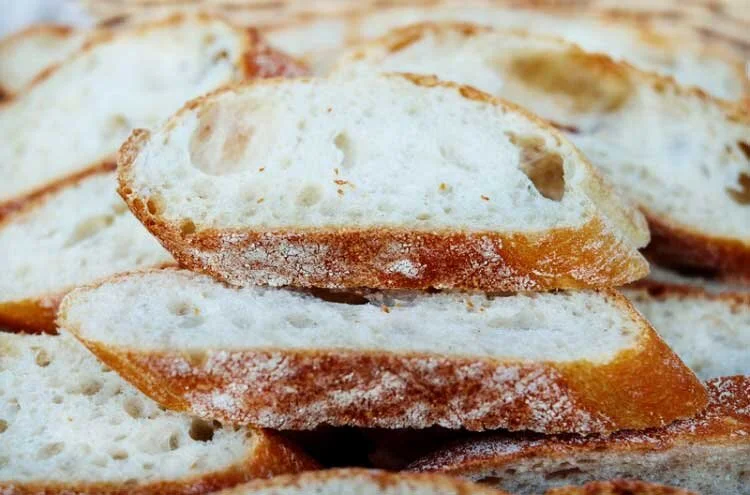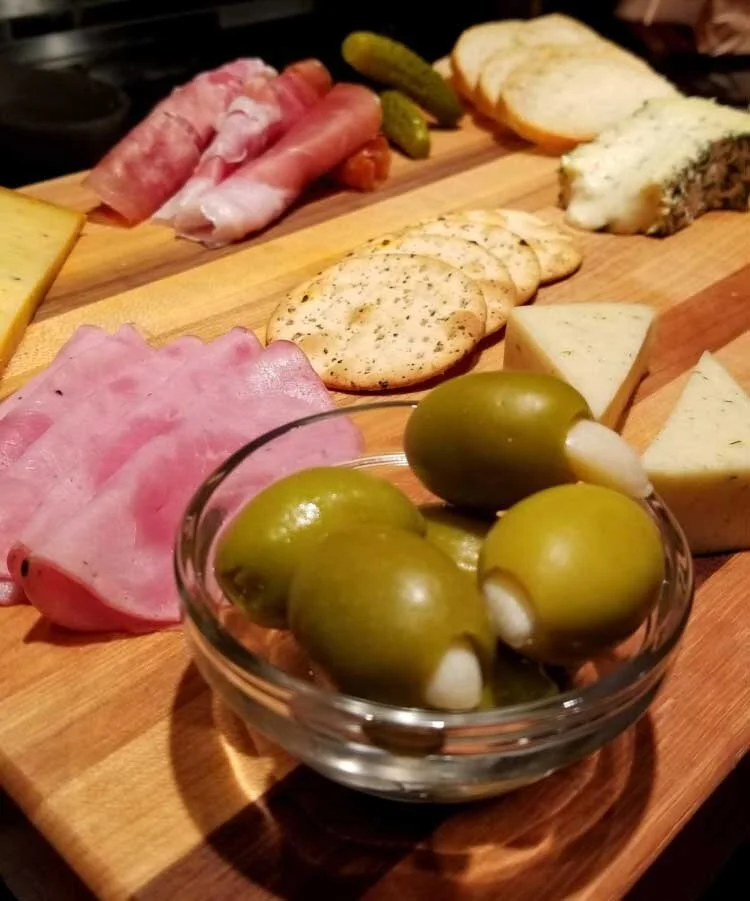How to Make a Completely Acceptable Charcuterie Board
Historically speaking, charcuterie is the discipline of cooking that involves preserved meat products — usually pork. This originated back in the day before refrigerators were a thing, and so knowing how to cure meat to make it last was something of an art form. These days charcuterie is less about the preservation of pork products and more about jamming every meat and cheese under the sun onto a too small board and then Instagramming it for all of your followers to drool over.
Slightly less facetiously, modern charcuterie boards usually involve a variety of different meats, cheeses, and other palate cleansing side dishes. So yeah, technically we’re talking about charcuterie and cheese boards in this post, but when we say charcuterie we’re referencing both the meat and cheese component, partially because we’re lazy, and partially because the language has somewhat evolved — search for “charcuterie” and you’ll see both meat and cheese on a board.
Google doesn’t lie. Right?
What is Typically on a Charcuterie Board?
A good charcuterie platter has a balance of meats, cheeses, and accompaniments. That being said, there are no hard and fast rules about charcuterie. There are guidelines you can follow, but the main thing to remember is: choose flavours that you enjoy! Don’t like blue cheese? Don’t include it on your board. Can’t handle spicy food? No need to add spicy Genoa salami. Of course you want the flavours to work well together, but remember: it’s your board — so your rules.
The hardest part about charcuterie is picking out what you want on your board! Below are a few ideas to get you started.
Meats
The actual charcuterie on your charcuterie board. Include a variety of cured meat, sausage, and salami. Your grocery store deli will have many options to choose from, but we recommend also checking out a local deli or artisan food market if you have one — they’ll likely have unique flavour profiles to try!
A few delicious choices for meats include:
Genoa salami
Prosciutto
Capicola
Sopressata
Coppa
Chorizo
Honorable mention: paté or terrine. We’re not huge fans, but it’s a thing that people like.
Try all of the meats.
Cheeses
An important thing to remember is to not serve your cheese straight from the refrigerator! Coldness mutes the flavour of cheese and it also makes it harder to cut. You ever try to cut cold aged cheddar? Yeah, have fun doing that with a dull ass cheese knife. Room temperature cheese? No problem.
Next up, you’re going to want to have a variety of cheeses on hand. How many different cheeses should you have? That’s up to you, but conventional cheese board wisdom recommends having at least three — a soft cheese, a hard cheese, and a blue cheese.
We aren’t huge fans of blue cheese, but again: it’s your board, so your rules. Want three types of cheddar on your board? Do it. Want two soft cheeses? Go for it.
Gouda, Havarti, Gruyere, Brie, Manchego, Camembert… Haven’t had one of these cheeses before? This is the perfect time to try something new!
Sweet dreams are made of cheese.
If this is your first time making a charcuterie board go to a local cheese shop and pick up a few different cheeses that sound like they might taste good. You don’t have to buy in large quantities — we got between 100g and 200g (that’s 3.5 oz - 7 oz) depending on the cheese. It’s enough to safely try some new flavours without busting your wallet. Of course, if you don’t have a local cheese shop and your grocery deli only sells pre-packaged cheeses, then you might have to play it a bit safe. (But money spent on cheese is money well-spent!)
Bread
Bread and crackers — the vehicle for your meat and cheese. This could include a sliced baguette, water crackers, or grain crackers. You could also go against the status quo include toasted flatbread or sourdough bread — get creative! Not much else to say here besides mmm, carbs.
🍷 Mediocre Tip: All charcuterie boards go great with wine. (Duh!)
Accompaniments
Also known as accoutrements, but some people on the internet might get angry if you call it that.
What separates a good charcuterie platter from great charcuterie platter is the accompaniments that tie everything together. They can balance flavours and create new flavour profiles that will keep your taste buds interested and wanting more. Consider adding a few of the following accompaniments to your board:
Nuts: almonds, cashews, pistachios
Fruit: apples, pears, pitted dates, fresh berries, dried apricots, figs
Pickles: olives, cornichons, pepperoncinis
Other: jams, preserves, dips, mustards, honey, artichoke hearts
Try to find a balance between savoury and sweet, and think about how the accompaniments will work with the meats and cheeses you’ve selected for your board! It can be trial-and-error, but that just means eating more meat and cheese, which we don’t object to at all.
What Should I Serve My Charcuterie On?
The honest answer here is any sort of flat surface. Usually charcuterie is presented on a slate or wooden board. Whether you go with the traditional boards, or use something else like a marble, stainless steel, or mirrored glass board (fancy) — as long as it’s a clean and flat surface, you’re good. If you don’t have a fancy platter, a plate will do of course.
🧀 Mediocre Tip: You’ll also need a tiny bowl or two to hold your accompaniments (e.g. a bowl for your olives) as well as a cheese knife or two, depending on how many cheeses you include on your board.
Arranging Your Board
Arrangement of a board is highly subjective and there are ton of things to consider. As with all culinary plating, you should create some sort of visual interest on the plate. Think of that bland ass fettuccine alfredo you’ve had at a chain restaurant — it’s usually just slopped haphazardly onto a plate with a sad piece of garlic bread shoved on the side. There’s no visual interest there. Sure you can just dump everything onto the board and call it done, but you can do better! If you’re truly stuck then we have a quick and dirty method that you can use:
Pick a spot on the edge of the board. Place something there.
Working clockwise, alternate placing meats and cheeses around the edges. Place as many or as few as you want.
Fill in the gaps with your accompaniments.
Fill in the center with more meat and cheese or accompaniments.
This should give you a rough arrangement — swap things around until you’re satisfied. Play with different or contrasting colours, maybe place bread or crackers on the side instead of a cheese or meat. Experiment with different meat presentations (rolled, crumpled, folded, etc.). Make the board your own by arranging it in a way that you like!
This board started by placing the olives in the corner.
Unpopular opinion time: we like negative space on our boards. A lot of charcuterie boards tend to be packed to the absolute limit with meat, cheese, and bread. Our recommendation is to not do that, for a couple of reasons:
Negative space between items allows the eye to better focus on each item. Boards that are over packed often suffer from the “I don’t know where to begin with this thing” problem. People don’t want to be the first to take something from one of these stuffed boards and ruin the homogeneous nature of the board — no one wants to ruin the pretty charcuterie board and break the symmetry. We think that boards with negative space included make you feel less guilty about taking something as there’s already gaps there — they’re more inviting.
Negative space gives you a chance to group together items that should be eaten together. Maybe you found a fantastic jam that pairs well with the brie that you bought. Grouping them together and allowing a bit of negative space between that cluster and the rest of your items suggests to your guests that they should be eaten together. It’s a subtle yet simple trick that can help guide people on how your board should be enjoyed.
(Thanks for listening to our TED talk about charcuterie psychology.)
Charcuterie Board Ideas
With so many options and flavour combinations, it can be hard to know where to start. To make your board, you can choose meats and cheeses that you like, or you can go with a theme (e.g. flavours around the world) or choose a season (e.g. summer).
We sampled a variety of meats and cheeses before deciding what we put on our board. Here is what we came up with:
Trevor’s Board
Meats: prosciutto, capicola, Genoa salami, sun dried tomato turkey breast, garlic sausage, sopressata, juniper pepperoni sticks
Cheeses: aged Irish cheddar, triple creamed Brie, and Gruyere
Bread: sliced baguette
Accompaniments: grapes, pitted dates, almonds, balsamic Saskatoon berry jam
Theme: Flavours That Trevor Likes
I’ve made cheap variations of this board before, so I knew going into it that I really enjoyed all of the individual components. Basically I just choose things that I knew tasted good — that’s all you really have to do. My arrangement philosophy was to use the quick and dirty algorithm as a starting point and go from there. I ended up having less negative space than Brittany’s board, but there is still some negative space to avoid the overcrowding problem. Obviously, in hindsight I would change a few things, but all in all, I think it works quite well.
Brittany’s Board
Meats: prosciutto, capicola, garlic sausage
Cheeses: sundried tomato and olive Gouda, dill Havarti, garlic and herb d’affinois
Breads: sliced baguette, roasted garlic and herb crackers
Accompaniments: garlic olives, dill pickles with garlic, grapes
Theme: An Ode To Garlic
I like garlic, so I made a garlic-themed charcuterie board. And oh boy, was it garlicky and delicious — exactly what I wanted. Some people would say this is unbalanced, but I believe I achieved some balance as not every single item on the board has garlic in it. (Which was my original plan.) Garlic lovers, unite!
Need more charcuterie inspiration? The charcuterie possibilities are endless!
This blog post has different themed boards. (But ignore the one that’s practically a salad… we’re only slightly judging.)
Don’t let anyone tell you there is a “right way” to make a charcuterie board. If someone tells you there are rules, well, rules are made to be broken, right? We also wanted to let you know that it’s totally okay to make a charcuterie board for yourself — why share?
Also, huge shout out to Paddy’s International Cheese Market, Meuwly’s, and Italian Centre for dealing with our large orders and being very helpful! We’ll definitely be back for more delicious meats and cheeses. If you’re in Edmonton, check them out!
What do you always put on your charcuterie board? Let us know in the comments below!







